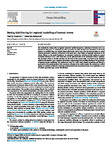Setting tidal forcing for regional modelling of internal waves
| dc.contributor.author | Vlasenko, Vasyl | |
| dc.contributor.author | Stashchuk, Nataliya | |
| dc.date.accessioned | 2021-09-13T15:01:04Z | |
| dc.date.available | 2021-09-13T15:01:04Z | |
| dc.date.issued | 2021-04 | |
| dc.identifier.issn | 1463-5003 | |
| dc.identifier.issn | 1463-5011 | |
| dc.identifier.other | 101767 | |
| dc.identifier.uri | http://hdl.handle.net/10026.1/17786 | |
| dc.description.abstract |
Two methods for setting tides in regional numerical models focussed on replication of internal waves are discussed in this paper. A traditional procedure prescribes the tidal forcing at the boundaries of the model domain. As it follows from our analysis, this method works well in some cases but does not allow to control identical generation conditions in all points of the model grid. Tidal ellipses are spatially dependent on the relative distance to the model boundaries. An alternative method for activation of tidal motions in general circulation models is to set a tidal body force on the right-hand side of the momentum balance equations. The procedure of how to do this correctly is in the focus of the present study. It is based on the analytical solution of the shallow water equations and includes compensating terms providing blockage of the generation of spurious inertial oscillations. The method was tested in a wide range of input parameters and showed a good match of the model-predicted tidal currents in all points of the model domain. The method was verified against an analytical solution by comparing model-predicted and theoretical internal wave amplitudes in case of realistic pycnocline-type oceanic stratification. | |
| dc.format.extent | 101767-101767 | |
| dc.language | en | |
| dc.language.iso | en | |
| dc.publisher | Elsevier BV | |
| dc.subject | Numerical models | |
| dc.subject | Tides | |
| dc.subject | Analytical solution | |
| dc.subject | Internal waves | |
| dc.title | Setting tidal forcing for regional modelling of internal waves | |
| dc.type | journal-article | |
| dc.type | Journal Article | |
| plymouth.author-url | https://www.webofscience.com/api/gateway?GWVersion=2&SrcApp=PARTNER_APP&SrcAuth=LinksAMR&KeyUT=WOS:000634606800002&DestLinkType=FullRecord&DestApp=ALL_WOS&UsrCustomerID=11bb513d99f797142bcfeffcc58ea008 | |
| plymouth.volume | 160 | |
| plymouth.publication-status | Published | |
| plymouth.journal | Ocean Modelling | |
| dc.identifier.doi | 10.1016/j.ocemod.2021.101767 | |
| plymouth.organisational-group | /Plymouth | |
| plymouth.organisational-group | /Plymouth/Faculty of Science and Engineering | |
| plymouth.organisational-group | /Plymouth/Faculty of Science and Engineering/School of Biological and Marine Sciences | |
| plymouth.organisational-group | /Plymouth/REF 2021 Researchers by UoA | |
| plymouth.organisational-group | /Plymouth/REF 2021 Researchers by UoA/UoA07 Earth Systems and Environmental Sciences | |
| plymouth.organisational-group | /Plymouth/Research Groups | |
| plymouth.organisational-group | /Plymouth/Research Groups/Marine Institute | |
| plymouth.organisational-group | /Plymouth/Users by role | |
| plymouth.organisational-group | /Plymouth/Users by role/Academics | |
| dcterms.dateAccepted | 2021-02-07 | |
| dc.rights.embargodate | 2021-9-16 | |
| dc.identifier.eissn | 1463-5011 | |
| dc.rights.embargoperiod | Not known | |
| rioxxterms.versionofrecord | 10.1016/j.ocemod.2021.101767 | |
| rioxxterms.licenseref.uri | http://www.rioxx.net/licenses/all-rights-reserved | |
| rioxxterms.licenseref.startdate | 2021-04 | |
| rioxxterms.type | Journal Article/Review | |
| plymouth.funder | Influence of population connectivity on depth-dependent diversity of deep-sea marine benthic biota::NERC |


